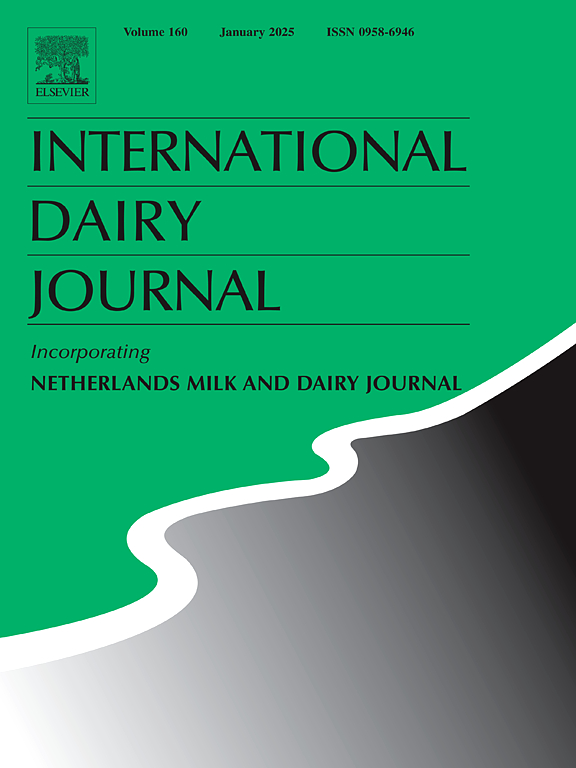Genome-based identification, and characterization of a bacteriocin selective inhibiting Penicillium citrinum in yak yogurt
IF 3.4
3区 农林科学
Q2 FOOD SCIENCE & TECHNOLOGY
引用次数: 0
Abstract
This study purified, identified, and characterized SN-F1, a novel bacteriocin produced by Limosilactobacillus fermentum SN-1 isolated from traditional Qinghai yak yogurt. SN-F1 was extracted using ethyl acetate and purified through multistep chromatography (cation-exchange, gel filtration, and semi-preparative RP-HPLC). Tricine-SDS-PAGE and HPLC-MS/MS analysis revealed SN-F1 has a molecular mass of 2859.29 Da and a novel sequence (NINDQWLVLSSTQAAKLQALMKDVTA), classifying it as a class II bacteriocin. SN-F1 exhibited broad-spectrum antimicrobial activity, inhibiting the key dairy spoilage mold Penicillium citrinum GLM6, various Gram-positive and Gram-negative foodborne pathogens, and several yeasts. The bacteriocin demonstrated significant thermostability (retained activity after 121 °C for 20 min) and high stability across a wide pH range (pH 2–8), but was completely inactivated by proteases (trypsin, protease K, papain, pepsin, flavor protease). Molecular docking elucidated the interaction forces and specific binding sites between SN-F1 and target cell membrane proteins. Crucially, incorporating SN-F1-producing L. fermentum SN-1 into fermentations with other functional lactic acid bacteria successfully produced enhanced traditional dairy products, confirming SN-F1's effective antibacterial activity.
牦牛酸奶中细菌素选择性抑制青霉的基因组鉴定和特性研究
本研究从传统青海牦牛酸奶中分离得到发酵乳酸乳酸杆菌SN-1,并对其产生的新型细菌素SN-F1进行了纯化、鉴定和表征。SN-F1采用乙酸乙酯萃取,采用阳离子交换、凝胶过滤、半制备反相高效液相色谱等多级色谱法纯化。Tricine-SDS-PAGE和HPLC-MS/MS分析显示,SN-F1的分子量为2859.29 Da,具有一个新的序列(NINDQWLVLSSTQAAKLQALMKDVTA),属于II类细菌素。SN-F1具有广谱抗菌活性,可抑制关键乳制品腐败霉菌柑橘青霉GLM6、多种革兰氏阳性和革兰氏阴性食源性致病菌以及几种酵母。细菌素表现出显著的热稳定性(在121°C后20分钟保持活性)和在宽pH范围内(pH 2-8)的高稳定性,但被蛋白酶(胰蛋白酶、蛋白酶K、木瓜蛋白酶、胃蛋白酶、风味蛋白酶)完全灭活。分子对接阐明了SN-F1与靶细胞膜蛋白之间的相互作用力和特异性结合位点。至关重要的是,将产生SN-F1的发酵乳杆菌SN-1与其他功能性乳酸菌一起发酵,成功地生产了增强的传统乳制品,证实了SN-F1的有效抗菌活性。
本文章由计算机程序翻译,如有差异,请以英文原文为准。
求助全文
约1分钟内获得全文
求助全文
来源期刊

International Dairy Journal
工程技术-食品科技
CiteScore
6.50
自引率
9.70%
发文量
200
审稿时长
49 days
期刊介绍:
The International Dairy Journal publishes significant advancements in dairy science and technology in the form of research articles and critical reviews that are of relevance to the broader international dairy community. Within this scope, research on the science and technology of milk and dairy products and the nutritional and health aspects of dairy foods are included; the journal pays particular attention to applied research and its interface with the dairy industry.
The journal''s coverage includes the following, where directly applicable to dairy science and technology:
• Chemistry and physico-chemical properties of milk constituents
• Microbiology, food safety, enzymology, biotechnology
• Processing and engineering
• Emulsion science, food structure, and texture
• Raw material quality and effect on relevant products
• Flavour and off-flavour development
• Technological functionality and applications of dairy ingredients
• Sensory and consumer sciences
• Nutrition and substantiation of human health implications of milk components or dairy products
International Dairy Journal does not publish papers related to milk production, animal health and other aspects of on-farm milk production unless there is a clear relationship to dairy technology, human health or final product quality.
 求助内容:
求助内容: 应助结果提醒方式:
应助结果提醒方式:


